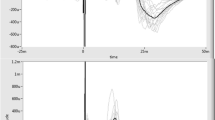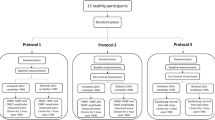Abstract
The aim of this study was to examine the effects of repeated volitional saliva swallowing on corticobulbar excitability recorded during two muscle preactivation conditions of the submental muscle group. Motor-evoked potentials (MEPs), elicited by transcranial magnetic stimulation (TMS), were assessed in ten healthy volunteers prior to and at 5, 30, 60, and 90 min after 60 volitional saliva swallows (Protocol A). To control for intrinsic fluctuations in corticobulbar excitability during this assessment period, MEPs were also recorded, on a different day, at 30-min intervals across a 2-h period (Protocol B). At each assessment, 15 MEPs were recorded during two submental muscle preactivation conditions: volitional contraction and contraction associated with the pharyngeal phase of volitional swallowing. There were no significant effects of repetitive volitional swallowing or time on MEP measures (p > 0.05). We conclude that volitional saliva swallowing does not have immediate effects on the excitability of corticobulbar projections to the submental musculature during volitionally initiated swallowing motor tasks. These results provide no evidence for use-dependent potentiation of corticobulbar excitability through repetitive saliva swallowing. The lack of effects of time on mean MEP measures supports previous reports of good intrasession reliability of MEPs as a measure of corticobulbar excitability.



Similar content being viewed by others
References
Kahrilas PJ, Logemann JA, Krugler C, Flanagan E. Volitional augmentation of upper esophageal sphincter opening during swallowing. Am J Physiol. 1991;260:G450–6.
Kahrilas PJ, Logemann JA, Gibbons P. Food intake by maneuver: an extreme compensation for impaired swallowing. Dysphagia. 1992;7:155–9.
Huckabee ML, Butler SG, Barclay M, Jit S. Submental surface electromyographic measurement and pharyngeal pressures during normal and effortful swallowing. Arch Phys Med Rehabil. 2005;86:2144–9.
Huckabee ML, Steele CM. An analysis of lingual contribution to submental surface electromyographic measures and pharyngeal pressure during effortful swallow. Arch Phys Med Rehabil. 2006;87:1067–72.
Logemann JA, Kahrilas PJ. Relearning to swallow post CVA: application of maneuvers and indirect biofeedback: a case study. Neurology. 1990;40:1136–8.
Fujiu MJ, Logemann JA, Pauloske BR. Increased postoperative posterior pharyngeal wall movement in patients with oral cancer: preliminary findings and possible implications for treatment. Am J Speech Lang Pathol. 1995;4:24–30.
Fujiu M, Logemann JA. Effect of a tongue-holding maneuver on posterior pharyngeal wall movement during deglutition. Am J Speech Lang Pathol. 1996;5:23–30.
Doeltgen SH, Witte U, Gumbley F, Huckabee ML. Evaluation of manometric measures during tongue-hold swallows. Am J Speech Lang Pathol. 2009;18:65–73.
Doeltgen SH, Dalrymple-Alford J, Ridding MC, Huckabee ML. Differential effects of neuromuscular electrical stimulation parameters on submental motor evoked potentials. Neurorehabil Neural Repair. 2010;24(6):519–27.
Fraser C, Power M, Hamdy S, Rothwell J, Hobday D, Hollander I, Hollander I, Tyrell P, Hobson A, Williams S, Thompson D. Driving plasticity in human adult motor cortex is associated with improved motor function after brain injury. Neuron. 2002;34(5):831–40.
Power M, Fraser C, Hobson A, Rothwell J, Mistry S, Nicholson D, Thompson DG, Hamdy S. Changes in pharyngeal corticobulbar excitability and swallowing behaviour after oral stimulation. Am J Physiol Gastrointest Liver Physiol. 2004;286(1):45–50.
Fraser C, Rothwell J, Power M, Hobson A, Thompson D, Hamdy S. Differential changes in human pharyngoesophageal motor excitability induced by swallowing, pharyngeal stimulation, and anesthesia. Am J Physiol Gastrointest Liver Physiol. 2003;285:137–44.
Cruccu G, Berardelli A, Inghilleri M, Manfredi M. Functional organization of the trigeminal motor system in man. Brain. 1990;112:1333–50.
McMillan AS, Watson C, Walshaw G. Improved reproducibility of magnetic stimulation-evoked motor potentials in the human masseter muscle by a new method for locating stimulation sites on the scalp. Arch Oral Biol. 1998;43:665–8.
Jean A. Brainstem control of swallowing: localization and organization of the central pattern generator for swallowing. In: Taylor A, editor. Neurophysiology of the jaw and teeth. New York: Macmillan; 1990. p. 294–321.
Miller RM, Chang MW. Advances in the management of dysphagia caused by stroke. Phys Med Rehabil Clin N Am. 1999;10(4):925–41.
Jean A. Brain stem control of swallowing: neuronal network and cellular mechanisms. Physiol Rev. 2001;81:929–69.
Kern M, Birn R, Jaradeh S, Jesmanowicz A, Cox R, Hyde J, Shaker R. Swallow-related cerebral cortical activity maps are not specific to deglutition. Am J Physiol Gastrointest Liver Physiol. 2001;280(4):G531–8.
Martin RE, MacIntosh BJ, Smith RC, Barr AM, Stevens TK, Gati JS, Menon RS. Cerebral areas processing swallowing and tongue movement are overlapping but distinct: a functional magnetic resonance imaging study. J Neurophysiol. 2004;92(4):2428–43.
Doeltgen SH, Ridding M, O’Beirne G, Dalrymple-Alford J, Huckabee ML. Test-retest reliability of motor evoked potentials (MEPs) at the submental muscle group during volitional swallowing. J Neurosci Methods. 2009;178(1):134–7.
Bütefisch CM, Davis BC, Wise SP, Sawaki L, Kopylev L, Classen J, Cohen LG. Mechanisms of use-dependent plasticity in the human motor cortex. Proc Natl Acad Sci USA. 2000;97:3661–5.
Wassermann EM. Inter- and intra-individual variation in the response to TMS. In: Wassermann EM, Epstein CM, Ziemann U, Walsh V, Paus T, Lisanby SH, editors. The Oxford handbook of transcranial stimulation. New York: Oxford University Press; 2008.
Plowman-Prine E, Triggs W, Malcolm M, Rosenbek J. Reliability of transcranial magnetic stimulation for mapping swallowing musculature in the human motor cortex. Clin Neurophysiol. 2008;119:2298–303.
Cacchio A, Cimini N, Alosi P, Santilli V, Marrelli A. Reliability of transcranial magnetic stimulation-related measurements of tibialis anterior muscle in healthy subjects. Clin Neurophysiol. 2009;120(2):414–9.
Author information
Authors and Affiliations
Corresponding author
Rights and permissions
About this article
Cite this article
Al-Toubi, A.K., Abu-Hijleh, A., Huckabee, ML. et al. Effects of Repeated Volitional Swallowing on the Excitability of Submental Corticobulbar Motor Pathways. Dysphagia 26, 311–317 (2011). https://doi.org/10.1007/s00455-010-9313-1
Received:
Accepted:
Published:
Issue Date:
DOI: https://doi.org/10.1007/s00455-010-9313-1




